 P. ramorum-infected seedlings in a nursery; photo by USDA APHIS
P. ramorum-infected seedlings in a nursery; photo by USDA APHIS
As I blogged on 2 August, the USDA Animal and Plant Health Inspection Service (APHIS) is proposing to update its regulations intended to prevent spread of the sudden oak death (SOD) pathogen (Phytophthora ramorum) via movement of nursery stock. The proposal is to incorporate into formal regulations several changes made through temporary “Federal Orders” issued in 2014 and 2015. This might sound boring – but it was actually an important opportunity to press APHIS to correct weaknesses in its current regulatory system. Whether APHIS’ ultimate program is weak or strong will affect how well we protect our forests against every kind of pest, not just SOD.
Unfortunately, few organizations seized this opportunity. Comments were submitted by only five organizations and three individuals. The organizations were the Center for Invasive Species Prevention, California Oak Mortality Task Force, several nursery industry associations in a joint comment, and the state departments of agriculture from Florida and Pennsylvania. It is most unfortunate that the other states appear to have given up on influencing APHIS’ decisions and did not comment. (Given the long history of APHIS failure to support states trying to adopt protective regulations – as described in Chapter 3 of my report Fading Forests III, available here – perhaps this is understandable.)
The Pennsylvania Department of Agriculture (DoA) was quite critical of the proposal in its comments. It complained that APHIS is not consistent in the way it regulates various quarantine pests and the vectors on which they might be transported. Allowing shipping nurseries to submit fewer samples for testing and providing less regulatory oversight does not help protect receiving states such as Pennsylvania.
The Pennsylvania DoA noted that the Plant Protection Act has a preemption clause which prevents states from adopting regulations more stringent than those instituted by APHIS. While the law allows for exceptions if the state can demonstrate a special need, none of the five applications for an exemption pertaining to P. ramorum has been approved. (The Environmental Law Institute addressed this issue in 2011; see source at end of the blog.)
Copies of all comments can be viewed here. Their main critiques of APHIS’ proposal include:
1) APHIS should mandate sampling at all nurseries selling SOD host or associated host plant species.
While any nursery that contains or sells host or associated host plant species can become infected, APHIS does not have any system for detecting P. ramorum in such nurseries which have been infection-free for three years. This point was made by CISP and the California Oak Mortality Task force (COMTF).
1(a) Risk associated with Nurseries in the Quarantine Zone
The Florida Department of Agriculture (FDACS) objected to allowing interstate shipment of any plants – both host and non-host species – from nurseries in the quarantine zones of California and Oregon. FDACS notes that where P. ramorum is in the natural environment, it is essentially impossible to be certain that available inoculum is not in the water column or soil and thus potentially to being shipped with containerized plants.
2) Level of risk.
APHIS says that the current regulations have reduced the risk of spread of P. ramorum via the nursery trade to a low risk. APHIS cites the fact that over a nine-year period (2004 – 2013), P. ramorum was detected at a “very small percentage—usually no more than 3 percent annually” of nurseries inspected under the current program. To the contrary, I (on behalf of CISP) argue that an annual level of risk of three percent is not a low level of risk, the nursery industry’s comments accept this level of risk as “low”.
3) Inspection, Sampling, and Certification Protocols
The Pennsylvania Department of Agriculture objects that while APHIS admits the pathogen might be transmitted in media, soil, water, potted material and containers, the proposed rule does nothing to assist states in protecting themselves from pathogen transport via these vectors. Pennsylvania DoA asked APHIS to provide greater oversight so as to ensure consistency in inspection and certification procedures.
I, on behalf of CISP, said all decisions should be based on sampling and testing of water, soil, growing media, pots, and plants (leaves, stems, roots). They should not rely only on visual inspection of plants.
The Florida Department of Agriculture did not address the certification procedure directly, but objected to allowing shipment of lots of plant material determined to be free of P. ramorum from a nursery in which infected plants have been detected. FDACS pointed out that infected plants could slip through because they were asymptomatic at the time of inspection or because leaves dropped from nearby infected plants contaminated the soil.
4) Updates to the List of Hosts Should Be Comprehensive
As I noted in my previous blog, APHIS’ proposed update does not include more than a dozen species growing in the wild or in gardens in the Pacific Northwest that scientists have identified as hosts of P. ramorum; and would designate Japanese larch (Larix kaempferi) as only an “associated” host.
The California Oak Mortality Task Force raised similar issues and warned that unexplained gaps in the host list cause unnecessary confusion and undermine the scientific foundation of regulations.
Source
Porter, R.D. and N.C. Robertson. 2011. Tracking Implementation of the Special Need Request Process Under the Plant Protection Act. Environmental Law Reporter. 41.
Posted by Faith Campbell
We welcome comments that supplement or correct factual information, suggest new approaches, or promote thoughtful consideration. We post comments that disagree with us — but not those we judge to be not civil or inflammatory.